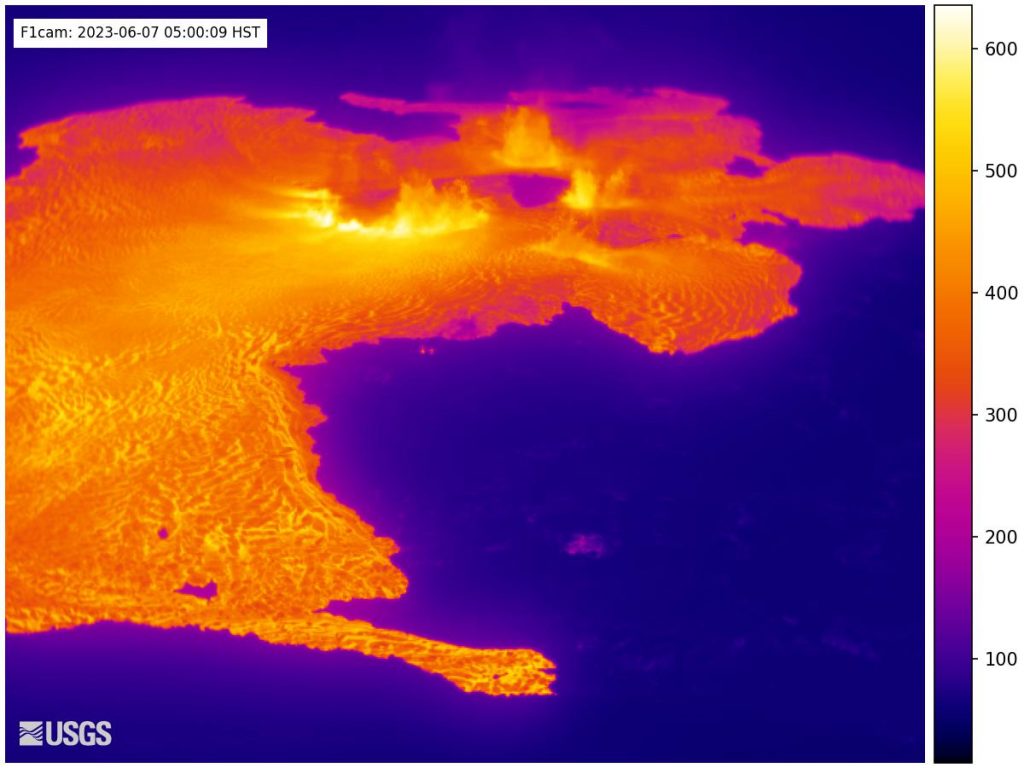Kīlauea volcano is erupting; watch LIVE stream
Fountain heights 13-20 feet
Update: 4 p.m., June 7, 2023
The summit eruption of Kīlauea that began within Halemaʻumaʻu crater at 4:44 a.m. on June 7, 2023, continues. All activity is confined to Kīlauea summit region, within Hawai‘i Volcanoes National Park. There are no indications of activity migrating out of the summit region according to the Hawaiian Volcanoes Observatory.
Multiple minor fountains are active on Halemaʻumaʻu crater floor; one fissure remains active on the southwest wall of the caldera. Fountain heights have decreased since the eruption onset and, as of approximately 3 p.m., were about 4-9 meters (13-30 feet) high. Initial lava flows inundated the crater floor (an area of approximately 1.5 square km or 370 acres) and added about 10 meters (32 feet) depth of new lava. A ring of elevated 1-2 meter-high (3-6 feet-high) lava surrounds the perimeter of the crater floor (like a bathtub ring), encircling continued lava flow activity across the crater floor.
Summit tilt switched from inflation to deflation around 5 a.m., shortly after the eruption onset. Summit earthquake activity greatly diminished following the eruption onset and was replaced by continuous eruptive tremor (a signal associated with fluid movement).
Volcanic gas emissions in the eruption area are elevated; a sulfur dioxide (SO2) emission rate of approximately 65,000 tonnes per day was measured between approximately 8 and 9 a.m., June 7, 2023. Residents of Pāhala, 20 miles (30 km) downwind of Kīlaueaʻs summit) reported a very light dusting of gritty fine ash and Pele’s hair.
Kīlauea’s volcano alert level and aviation color code will remain at WARNING/RED as hazards associated with the eruption onset are evaluated overnight.
Lava fountains as high as 50 feet form with bursts as high as 200 feet
Update: 9:05 a.m., June 7, 2023
At 9:05 a.m, the HVO reports that multiple minor fountains are active in the central eastern portion of Halema‘uma‘u crater floor and one vent is open on the west wall of the caldera, within the closed area of Hawai’i Volcanoes National Park. The largest lava fountain is consistently about 15 meters (50 feet) high; during the early phase of the eruption, fountain bursts reach at least approximately 60 meters (200 feet) high. Lava flows have inundated much of the crater floor (an area of approximately 370 acres or 150 hectares). As of approximately 8 a.m. about 10 meters (33 feet) depth of new lava had been added to the crater floor.
Kīlauea is erupting
Previous Post:
Kīlauea volcano is erupting. At approximately 4:44 a.m. on June 7, 2023, the USGS Hawaiian Volcano Observatory detected glow in Kīlauea summit webcam images indicating that an eruption has commenced within Halemaʻumaʻu crater in Kīlauea’s summit caldera, within Hawai‘i Volcanoes National Park.
The USGS Hawaiian Volcano Observatory is elevating Kīlauea’s volcano alert level from WATCH to WARNING and its aviation color code from ORANGE to RED as this eruption and associated hazards are evaluated.
The opening phases of eruptions are dynamic. Webcam imagery shows fissures at the base of Halemaʻumaʻu crater generating lava flows on the surface of the crater floor. The activity is confined to Halemaʻumaʻu and the hazards will be reassessed as the eruption progresses.
HVO is in constant communication with Hawai‘i Volcanoes National Park as this situation evolves. The activity is confined entirely within the park.
At 5:30 a.m., the National Weather Service issued an advisory saying very light ash fall is expected from Kīlauea through at least 6 p.m. A burst of volcanic emissions was observed at 4:44 a.m., and was observed on infra-red satellite imagery.
Radar indicates winds will cause any ash emissions to drift towards the west-southwest direction this morning. Communities in the Puna, Kaʻū and South Kona Districts may be affected. Those with respiratory sensitivities should take extra precautions to minimize exposure.



















